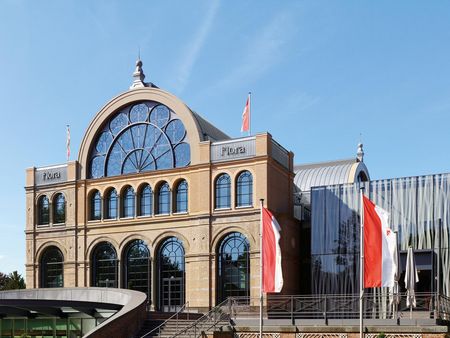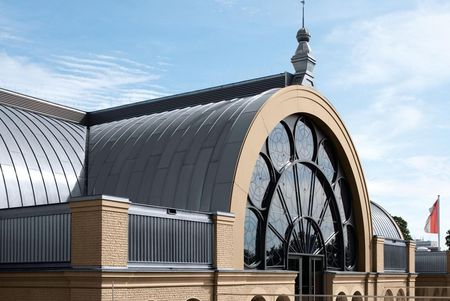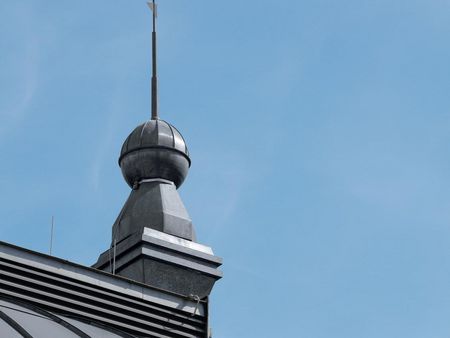Heritage conservation: Historical building with new zinc roof
Oversized domed roof of the Flora main building in Cologne renewed
Although zinc was only first established as a metal in Europe at the beginning of the 17th century, it was quickly adopted in vernacular architecture. The most important German architect of the 19th century, Karl Friedrich Schinkel, designed buildings using zinc for covers, flashing, ornamentation and roofing.
Since then, many historical buildings have been built with zinc roofs that have fulfilled their visual and technical functions for numerous decades. Today, these historic buildings must be refurbished in compliance with heritage conservation standards.
Zinc should be left as nature intended
There is no doubt that cheaper roofing materials are now available. These have a poorer ecological footprint and use artificial coatings to imitate the appearance of zinc for a certain time. However, in the long run, they will be recognised for the cheap solutions that they are.
For instance, when refurbishing the Flora building in Cologne, the decision was made to replace the roof with a real zinc roof, as in the refurbishment of many other listed buildings. Flora is the modern name for the glass palace built around 150 years ago that forms the centrepiece of the Cologne Botanical gardens.
The building was originally constructed in glass and iron. After its destruction in the Second World War, sufficient funds were not available to rebuild the building in its original form. Instead, the Flora was given a utilitarian tiled roof and was later used as a banqueting hall.
Reconstruction based on historical models
Around ten years ago, all operations in the building were ceased due to severe defects in the building's structure. A Complex refurbishments programme began five years later, in the summer of 2011. This time, the aim was to return the building to its original character and make the envelope more functional and less complicated. Plans included the reconstruction of the impressive barrel vault roof. The architects K+H Architekten from Stuttgart chose zinc standing seam roofing to achieve the required look.
A company was commissioned to carry out the extensive work on the barrel roof, which is around 1,400 square metres in size. By the end of the originally planned construction period, they had lost track and lost control of this complex refurbishment project. An expert employed to review the situation came to the conclusion that the work carried out had been slow and severely defective. The installation company was immediately relieved of its duties and another specialist company was found. As a result of these consequences the task of completing these works was passed on to master roofers Axel Ragas from Bergisch Gladbach who was awarded the contract and then completed the refurbishment of the barrel roof.
The structure of the barrel roof was planned using a trapezoidal steel profile over the entire surface area. This was followed by a bituminous vapour barrier. The curved surfaces were insulated using Rockwool insulation panels 200 mm thick. A breathable bitumen roof underlay with self-sealing lapped joints was installed on top of the insulation.
The original design brief allowed for titanium zinc roofing with standing seams and continuous roof profiles spanning from the eaves to the ridge. Master roofer Axel Ragas recommended dividing the curved panels with staggered joints to achieve the following. 1 traditional appearance, 2 easy to handle and transport and 3 simplified assembly on site. This recommended approach proved to be successful. The material used was 0.8 mm, bright rolled titanium zinc made by RHEINZINK. The bright rolled version was selected to give the roof a vibrant appearance and let the elements weather the material naturally to form the protective patina
New details on site
Further details that were vital to the project and need careful consideration included the fire safety requirements for the event halls and smoke extraction systems in the barrel roof. These visual breaks were not included in the original design brief and had to be carefully integrated into the roof build up. The installation company added a raised a central portion of the roof to do this. With the standing seams following the curve of the roof in a single line creates the effect of an unbroken line. Drainage for the building also had to be carefully planned. The heritage authorities stipulated that the drainage design must be as discreet as possible. As header boxes and curved elements were not permitted, the specialists had to construct every branch in the square downpipes from many small segments. Flashing and windowsills were also made from the same material as the roofing. Material 1.0 mm thick was used for this purpose.
Thanks to the accurate and detailed refurbishment of this zinc roof, the Cologne Flora will be enjoyed by many generations to come. The Flora building will tower over the botanical gardens for another 150 years as a testimony to 19th-century history and culture.
Listed buildings as investment property
Refurbishing listed buildings is no easy task. But it is possible with the right partners and the right products. Clever capital investors can even take advantage of tax benefits through targeted investment in listed properties:
- During the first seven years, 9% of the costs can be declared for tax purposes on rented properties.
- Private individuals who refurbish a listed building and live in it themselves can even declare 9% of the costs for tax purposes over the first ten years.
Furthermore, listed buildings can either be exempted from property tax or the assessed value can be reduced, which affects the amount of property tax. This compensates the increased cost of refurbishment and promotes the preservation of listed buildings.
Listed buildings successfully refurbished
It is a well-known fact that strict regulations must be observed when refurbishing listed buildings. Seen in a positive light, many heritage authorities demand high levels of accuracy. For instance, elements of listed buildings that form their characters must be retained. Good examples of these elements include characteristic architectural details, such as railings, cladding, cornices and similar elements, that can differ significantly from one epoch to another. If a building is many years old, it is commonly difficult to find products that match the products used to build the structure originally. Often, they are simply no longer produced in the same form as they have been replaced by more innovative products. Reproductions that are as accurate as possible are then required to be able to fulfil the official standards.
Many architectural details made by RHEINZINK can be adapted to individual requirements at an economically acceptable cost. As an experienced producer, RHEINZINK is very familiar with challenges of this kind and can manufacture individual, custom-made products in our usual high quality. We would advise you to contact us without obligation as every building and every element are particularly individual in cases of heritage conservation. Our expert employees can find out quickly whether we can implement your wishes in a face-to-face meeting.
If you have any questions concerning heritage conservation, just contact our specialist staff.
You are on our global website.
Would you like to stay on rheinzink.com or visit the local RHEINZINK America website?



